Schumacher XC75 User Manual 2
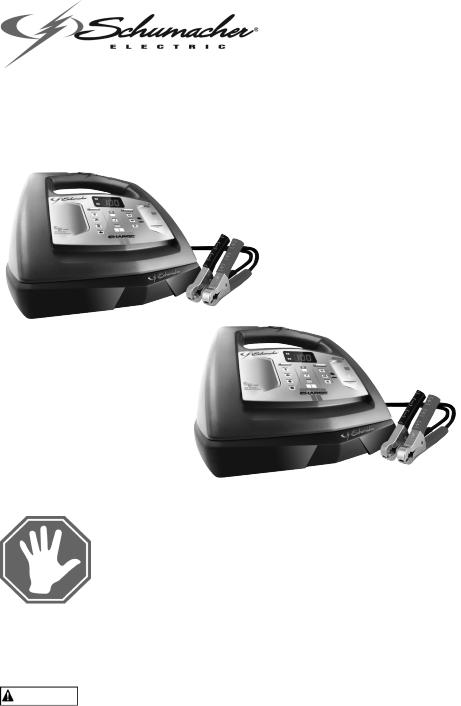
OWNER’S MANUAL
Manual del usuario
Models / Modelos: XC75 & XC103
Automatic Battery Charger / Cargador de batería automático
XC75
XC103
DO NOT RETURN THIS PRODUCT TO THE STORE!
Call Customer Service for Assistance: 800-621-5485
¡NO LO DEVUELVA este producto A LA TIENDA!
Llame a Servicios al Cliente para Asistencia: 800-621-5485
 READ THE ENTIRE MANUAL BEFORE USING THIS PRODUCT. FAILURE TO DO SO COULD RESULT IN SERIOUS INJURY OR DEATH.
READ THE ENTIRE MANUAL BEFORE USING THIS PRODUCT. FAILURE TO DO SO COULD RESULT IN SERIOUS INJURY OR DEATH.
ADVERTENCIA LEA EL MANUAL COMPLETO ANTES DE UTILIZAR ESTE PRODUCTO. CUALQUIER FALLA PODRÍA RESULTAR EN SERIAS LESIONES O PODRÍA SER MORTAL.
0099001038WB-01
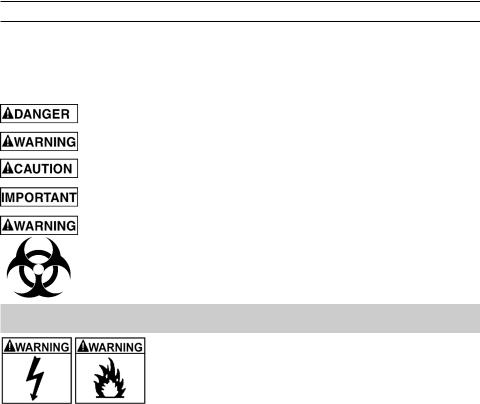
IMPORTANT: READ AND SAVE THIS SAFETY AND INSTRUCTION MANUAL.
SAVE THESE INSTRUCTIONS – This manual will show you how to use your charger safely and effectively. Please read, understand and follow these instructions and precautions carefully, as this manual contains important safety and operating
instructions. The safety messages used throughout this manual contain a signal word, a message and an icon.
The signal word indicates the level of the hazard in a situation.
Indicates an imminently hazardous situation which, if not avoided, will result in death or serious injury to the operator or bystanders.
Indicates a potentially hazardous situation which, if not avoided, could result in death or serious injury to the operator or bystanders.
Indicates a potentially hazardous situation which, if not avoided, could result in moderate or minor injury to the operator or bystanders.
Indicates a potentially hazardous situation which, if not avoided, could result in damage to the equipment or vehicle or property damage.
Pursuant to California Proposition 65, this product contains chemicals known to the State of California to cause cancer and birth defects or other reproductive harm.
1.IMPORTANT SAFETY INSTRUCTIONS – SAVE THESE INSTRUCTIONS
This manual contains important safety and operating instructions
RISK OF ELECTRIC SHOCK OR FIRE.
1.1Keep out of reach of children.
1.2Do not expose the charger to rain or snow.
1.3Use only recommended attachments. Use of an attachment not recommended or sold by Schumacher® Electric
Corporation may result in a risk of fire, electric shock or injury to
persons or damage to property.
1.4To reduce the risk of damage to the electric plug or cord, pull by the plug rather than the cord when disconnecting the charger.
1.5An extension cord should not be used unless absolutely necessary. Use of an improper extension cord could result in a risk of fire and electric shock. If an extension cord must be used, make sure:
•That the pins on the plug of the extension cord are the same number, size and shape as those of the plug on the charger.
•That the extension cord is properly wired and in good electrical condition.
•That the wire size is large enough for the AC ampere rating of the charger as specified in section 8.
1.6To reduce the risk of electric shock, unplug the charger from the outlet before attempting any maintenance or cleaning. Simply turning off the controls will not reduce this risk.
1.7Do not operate the charger with a damaged cord or plug; have the cord or plug replaced immediately by a qualified service person. (Call customer service at: 1-800-621-5485.)
1.8Do not operate the charger if it has received a sharp blow, been dropped or otherwise damaged in any way; take it to a qualified service person. (Call customer service at: 1-800-621-5485.)
1.9Do not disassemble the charger; take it to a qualified service person when service or repair is required. Incorrect reassembly may result in a risk of fire or electric shock. (Call customer service at: 1-800-621-5485.)
•1 •
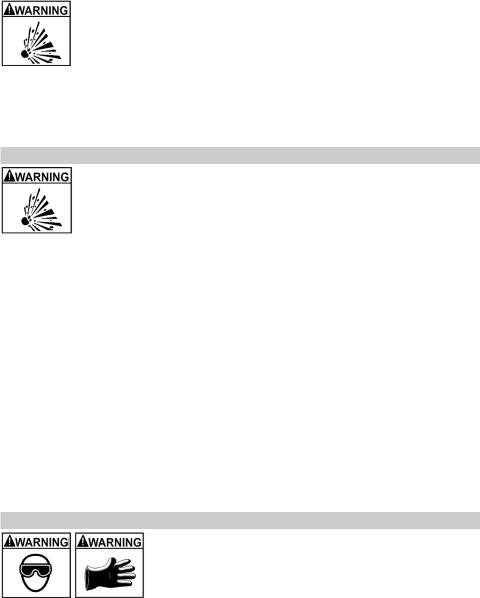
RISK OF EXPLOSIVE GASES.
1.10 WORKING IN THE VICINITY OF A LEAD-ACID BATTERY IS DANGEROUS. BATTERIES GENERATE EXPLOSIVE GASES DURING NORMAL BATTERY OPERATION. FOR THIS REASON, IT IS OF UTMOST IMPORTANCE THAT YOU FOLLOW THE INSTRUCTIONS EACH TIME YOU USE THE CHARGER.
1.11To reduce the risk of a battery explosion, follow these instructions and those published by the battery manufacturer and the manufacturer of any equipment you intend to use in the vicinity of the battery. Review the cautionary markings on these products and on the engine.
1.12This charger employs parts, such as switches and circuit breakers, that tend to produce arcs and sparks. If used in a garage, locate this charger 18 inches or more above floor level.
2.PERSONAL PRECAUTIONS
RISK OF EXPLOSIVE GASES.
2.1NEVER smoke or allow a spark or flame in the vicinity of a battery or engine.
2.2Remove personal metal items such as rings, bracelets, necklaces and watches when working with a lead-acid battery. A lead-acid battery can produce a short-circuit current high enough to weld a ring or the like to metal, causing a severe burn.
2.3Be extra cautious to reduce the risk of dropping a metal tool onto the battery. It might spark or short-circuit the battery or other electrical part that may cause an explosion.
2.4Use this charger for charging LEAD-ACID batteries only. It is not intended to supply power to a low voltage electrical system other than in a starter-motor application. Do not use this battery charger for charging dry-cell batteries that are commonly used with home
appliances. These batteries may burst and cause injury to persons and damage to property.
2.5NEVER charge a frozen battery.
2.6NEVER overcharge a battery.
2.7Consider having someone close enough by to come to your aid when you work near a lead-acid battery.
2.8Have plenty of fresh water and soap nearby in case battery acid contacts your skin, clothing or eyes.
2.9Wear complete eye and body protection, including safety goggles and protective clothing. Avoid touching your eyes while working near the battery.
2.10If battery acid contacts your skin or clothing, immediately wash the area with soap and water. If acid enters your eye, immediately flood the eye with cold running water for at least 10 minutes and get medical attention right away.
2.11If battery acid is accidentally swallowed, drink milk, the whites of eggs or water. DO NOT induce vomiting. Seek medical attention immediately.
3.PREPARING TO CHARGE
RISK OF CONTACT WITH BATTERY ACID. BATTERY ACID IS
A HIGHLY CORROSIVE SULFURIC ACID.
3.1If it is necessary to remove the battery from the vehicle to charge it, always remove the grounded terminal first. Make sure all of the accessories in the vehicle are off to prevent arcing.
3.2Be sure the area around the battery is well ventilated
while the battery is being charged.
3.3Clean the battery terminals before charging the battery. During cleaning, keep airborne corrosion from coming into contact with your eyes, nose and mouth. Use baking soda and water to neutralize the battery acid and help eliminate airborne corrosion. Do not touch your eyes, nose or mouth.
3.4Add distilled water to each cell until the battery acid reaches the level specified by the battery manufacturer. Do not overfill. For a battery without removable cell caps, such as valve regulated lead acid batteries (VRLA), carefully follow the manufacturer’s recharging instructions.
3.5Read, understand and follow all instructions for the charger, battery, vehicle and any equipment used near the battery and charger. Study all of the battery manufacturer’s specific precautions while charging and recommended rates of charge.
•2 •

3.6Determine the voltage of the battery by referring to the vehicle owner’s manual and make sure that the output voltage selector switch is set to the correct voltage (if applicable). If the charger has an adjustable charge rate, charge the battery in the lowest rate first.
3.7Make sure that the charger cable clips make tight connections.
4.CHARGER LOCATION
RISK OF EXPLOSION AND CONTACT WITH
BATTERY ACID.
4.1Locate the charger as far away from the battery as the DC cables permit.
4.2Never place the charger directly above the battery being charged; gases from the battery will
corrode and damage the charger.
4.3Do not set the battery on top of the charger.
4.4Never allow battery acid to drip onto the charger when reading the electrolyte specific gravity or filling the battery.
4.5Do not operate the charger in a closed-in area or restrict the ventilation in any way.
5.DC CONNECTION PRECAUTIONS
5.1Connect and disconnect the DC output clips only after setting all of the charger switches to the “off” position (if applicable) and removing the AC plug from the electrical outlet.
Never allow the clips to touch each other.
5.2Attach the clips to the battery and chassis, as indicated in sections 6 and 7.
6.FOLLOW THESE STEPS WHEN BATTERY IS INSTALLED IN VEHICLE
A SPARK NEAR THE BATTERY MAY CAUSE A
BATTERY EXPLOSION. TO REDUCE THE RISK OF A SPARK NEAR THE BATTERY:
6.1 Position the AC and DC cables to reduce the risk of damage by the hood, door and moving or hot engine parts. NOTE: If it is necessary to close the
hood during the charging process, ensure that the hood does not touch the metal part of the battery clips or cut the insulation of the cables.
6.2Stay clear of fan blades, belts, pulleys and other parts that can cause injury.
6.3Check the polarity of the battery posts. The POSITIVE (POS, P, +) battery post usually has a larger diameter then the NEGATIVE (NEG, N, -) post.
6.4Determine which post of the battery is grounded (connected) to the chassis. If the negative post is grounded to the chassis (as in most vehicles), see step 6.5. If the positive post is grounded to the chassis, see step 6.6.
6.5For a negative-grounded vehicle, connect the POSITIVE (RED) clip from the battery charger to the POSITIVE (POS, P, +) ungrounded post of the battery. Connect the NEGATIVE (BLACK) clip to the vehicle chassis or engine block away from the battery.
Do not connect the clip to the carburetor, fuel lines or sheet-metal body parts. Connect to a heavy gauge metal part of the frame or engine block.
6.6For a positive-grounded vehicle, connect the NEGATIVE (BLACK) clip from the battery charger to the NEGATIVE (NEG, N, -) ungrounded post of the battery. Connect the POSITIVE (RED) clip to the vehicle chassis or engine block away from the battery. Do not connect the clip to the carburetor, fuel lines or sheet-metal body parts. Connect to a heavy gauge metal part of the frame or engine block.
6.7Connect charger AC supply cord to electrical outlet.
6.8When disconnecting the charger, turn all switches to off (if applicable), disconnect the
AC cord, remove the clip from the vehicle chassis and then remove the clip from the battery terminal.
6.9See CALCULATING CHARGE TIME for length of charge information.
•3 •
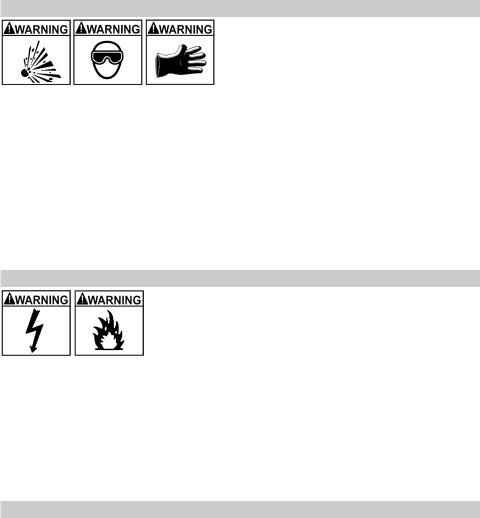
7.FOLLOW THESE STEPS WHEN BATTERY IS OUTSIDE VEHICLE
A SPARK NEAR THE BATTERY MAY CAUSE A BATTERY EXPLOSION. TO REDUCE THE RISK OF A SPARK NEAR THE BATTERY:
7.1 Check the polarity of the battery posts. The
POSITIVE (POS, P, +) battery post usually has a larger diameter than the NEGATIVE (NEG, N, -) post.
7.2Attach at least a 24-inch (61 cm) long 6-gauge (AWG) insulated battery cable to the NEGATIVE (NEG, N, -) battery post.
7.3Connect the POSITIVE (RED) charger clip to the POSITIVE (POS, P, +) post of the battery.
7.4Position yourself and the free end of the cable you previously attached to the NEGATIVE
(NEG, N, -) battery post as far away from the battery as possible – then connect the NEGATIVE (BLACK) charger clip to the free end of the cable.
7.5Do not face the battery when making the final connection.
7.6Connect charger AC supply cord to electrical outlet.
7.7When disconnecting the charger, always do so in the reverse order of the connecting procedure and break the first connection while as far away from the battery as practical.
7.8A marine (boat) battery must be removed and charged on shore. To charge it onboard requires equipment specially designed for marine use.
8.Grounding and AC power cord connections
RISK OF ELECTRIC SHOCK OR FIRE.
8.1 This battery charger is for use on a nominal 120-volt circuit. The plug must be plugged into an outlet that is properly installed and grounded in accordance with all local codes and ordinances. The plug pins must fit the receptacle (outlet). Do not use with an ungrounded system.
8.2 Never alter the AC cord or plug provided – if it does not fit the outlet, have a proper grounded outlet installed by a qualified electrician. An improper connection can result in a risk of an electric shock or electrocution.
Never alter the AC cord or plug provided – if it does not fit the outlet, have a proper grounded outlet installed by a qualified electrician. An improper connection can result in a risk of an electric shock or electrocution.
NOTE: Pursuant to Canadian Regulations, use of an adapter plug is not allowed in Canada. Use of an adapter plug in the United States is not recommended and should not be used.
8.3Recommended minimum AWG size for extension cord:
•100 feet (30.5 meters) long or less - use a 16 gauge (1.31mm2) extension cord.
•Over 100 feet (30.5 meters) long - use a 14 gauge (2.08mm2) extension cord.
9.Assembly instructions
9.1Remove all cord wraps and uncoil the cables prior to using the battery charger.
9.2Included with your charger are two cord wrap cleats for storage of the clip cables. To install, align the two tabs with the two receptacles on the back of the charger and push until you hear a snap.
• 4 •
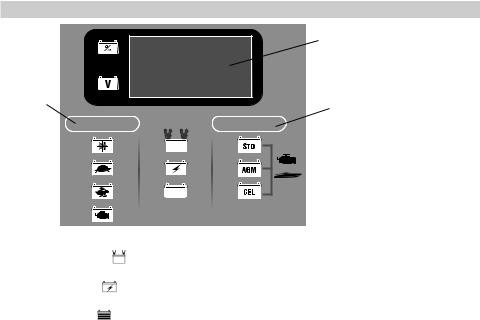
10.Charger controls
3
1 |
2 |
|
1. Charge Rate Button
2. Battery Type Button
3. Digital Display
LED Indicators
CONNECTED |
(red) LED lit: Indicates that the charger is properly connected to the |
battery. |
|
CHARGING |
(yellow) LED lit: Indicates the charger has detected a battery and is |
charging it. |
|
CHARGED |
(green) LED lit: Indicates the battery is fully charged and the charger is |
in maintain mode.
NOTE: See the Operating Instructions section for a complete description of the charger modes.
Digital Display
The Digital Display gives a digital indication of voltage, % of charge or time. The display will show the battery VOLTAGE when the charger is not charging a battery. When it goes into charging mode, the display will automatically change to ON (to show charging has started) and then show the percent-of-charge of the battery being charged and either 6 or 12 (the voltage the charger determined the battery is). If you manually stop the charging process (by pressing the CHARGE RATE button) before the battery is fully charged the display will show OFF.
•Battery % - The digital display shows an estimated charge percentage of the battery connected to the charger battery clips.
•Voltage – The Digital Display shows the voltage at the charger battery clips in DC volts.
Battery Type Button
Use this button to set the type of battery to be charged.
•Regular – Set the button to  .
.
•AGM – Set the button to  .
.
•GEL – Set the button to  .
.
Charge Rate Button
Use this button to set the maximum charge rate to one of the following:
•Maintain  - Used to keep stored, lead-acid batteries charged. Charges and maintains small batteries. Maintains large batteries that are already fully charged.
- Used to keep stored, lead-acid batteries charged. Charges and maintains small batteries. Maintains large batteries that are already fully charged.
•Slow Charge Rate  – Intended for charging small batteries such as those commonly used in garden tractors, snowmobiles and motorcycles. Also used to completely charge deep cycle batteries.
– Intended for charging small batteries such as those commonly used in garden tractors, snowmobiles and motorcycles. Also used to completely charge deep cycle batteries.
•Fast Charge Rate  - Use for charging automotive, marine and light truck batteries. Not intended for industrial applications.
- Use for charging automotive, marine and light truck batteries. Not intended for industrial applications.
•Engine Start  – Provides high amperage for cranking an engine with a weak or run down battery. Always use in combination with a battery.
– Provides high amperage for cranking an engine with a weak or run down battery. Always use in combination with a battery.
NOTE: Once the charger has started charging the battery; if you press the Charge Rate button once, the output current is shut off and the display with show OFF and then the
• 5 •

battery voltage. If you press the Charge Rate button again, the current will go back on at the same setting it was when it was turned off. For example: The charger is charging a battery at the slow charge rate setting. If you press the Charge Rate button, the output is turned off. If you press the Charge Rate button again, the output will turn back on at the slow charge rate setting.
11.Operating instructions
 This battery charger must be properly assembled in accordance with the assembly instructions before it is used.
This battery charger must be properly assembled in accordance with the assembly instructions before it is used.
Charging
1.Ensure that all of the charger components are in place and in good working condition, for example, the plastic boots on the battery clips.
2.Connect the battery following the precautions listed in sections 6 and 7.
3.Connect the AC power following the precautions listed in section 8. Make sure to place the charger on a dry, non-flammable surface like metal or concrete.
4.Select the appropriate settings for your battery.
Startup Defaults: When first turned on, the charger will default to the following startup settings:
•Battery Type: Standard
•Charge Rate: OFF (No charge rate selected)
After 10 minutes, if no charge rate is selected, the charger will automatically start charging at the following defaults:
•Charge Current: The lowest charge rate setting available, usually 2 amps.
•Charge Voltage: The lowest charge rate voltage available, usually 14.7 volts (Gel Cell), if not, then 15.4 volts (AGM), otherwise it will be 16.0 volts (Standard battery).
Battery Connection Indicator
If the charger does not detect a properly connected battery, the CONNECTED LED will not light. Charging will not begin if the CONNECTED LED  is not on.
is not on.
Automatic Charging Mode
When an Automatic Charge is performed, the charger switches to the Maintain Mode
(see below) automatically after the battery is charged.
Aborted Charge
If charging cannot be completed normally, charging will abort. When charging aborts, the charger’s output is shut off, all of the LEDs are turned off and the digital display will show an error code (see Troubleshooting for a list of error codes). In that state, the charger ignores all buttons. To reset after an aborted charge, unplug the charger.
Completion of Charge
Charge completion is indicated by the CHARGED LED . When lit, the charger has switched to the Maintain Mode of operation.
Maintain Mode (Float-Mode Monitoring)
When the CHARGED LED is lit, the charger has started Maintain Mode. In this mode, the charger keeps the battery fully charged by delivering a small current when necessary. The voltage is maintained at a level determined by the BATTERY TYPE selected. If the charger has to provide its maximum maintain current for a continuous
12 hour period, it will go into Abort Mode (see Aborted Charge section). This is usually caused by a drain on the battery, or the battery could be bad. Make sure there are
no loads on the battery. If there are, remove them. If there are none, have the battery checked or replaced.
NOTE: For 12V AGM and 12V GEL CELL battery types, the CHARGED LED might be lit before the Maintain Mode starts.
Maintaining a Battery (3A  Charge Rate)
Charge Rate)
The Schumacher XC75 and XC103 are battery chargers with a maintenance setting that maintains both 6 and 12 volt batteries, keeping them at full charge. On this setting, it can charge small batteries and maintain both small and large batteries. If you are maintaining a fully charged large battery, you will properly utilize the maintenance setting. However, if you use the maintenance setting to charge a large battery, such as a marine deep cycle battery, that was not fully charged, you may lose some of the battery’s capacity. This would
• 6 •
cause the large battery to be unable to hold a charge and become useless. Therefore, we do not recommend charging a large battery on the maintenance setting.
NOTE: The maintain mode technology utilized in Schumacher’s chargers allows you to safely charge and maintain a healthy battery for extended periods of time. However, problems with the battery, electrical problems in the vehicle, improper connections
or other unanticipated conditions could cause excessive current draws. As such, occasionally monitoring your battery and the charging process is recommended.
Using the Engine Start feature
Your battery charger can be used to jumpstart your car if the battery is low. Follow these instructions on how to use the ENGINE START feature.
 Follow all safety instructions and precautions for charging your battery. Wear complete eye protection and clothing protection. Charge your battery in a wellventilated area.
Follow all safety instructions and precautions for charging your battery. Wear complete eye protection and clothing protection. Charge your battery in a wellventilated area.
 Using the ENGINE START feature WITHOUT a battery installed in the vehicle could cause damage to the vehicle’s electrical system. NOTE: If you have charged the battery and it still will not start your car, do not use the engine start feature, or it could damage the vehicle’s electrical system.
Using the ENGINE START feature WITHOUT a battery installed in the vehicle could cause damage to the vehicle’s electrical system. NOTE: If you have charged the battery and it still will not start your car, do not use the engine start feature, or it could damage the vehicle’s electrical system.
1.With the charger plugged in and connected to the battery and chassis (see section 6), press the CHARGE RATE button until the ENGINE START LED  is lit.
is lit.
2.Crank the engine until it starts or 3 seconds pass. If the engine does not start, wait 3 minutes before cranking again. This allows the charger and battery to cool down.
NOTE: During extremely cold weather, or if the battery is under 2 volts, charge the battery for 5 minutes before cranking the engine.
3.If the engine fails to start, charge the battery for 5 more minutes before attempting to crank the engine again.
4.After the engine starts, move the charge rate selector switch to the off position and unplug the AC power cord before disconnecting the battery clips from the vehicle.
5.Clean and store the charger in a dry location.
NOTE: If the engine does turn over but never starts, there is not a problem with the starting system; there is a problem somewhere else with the vehicle. STOP cranking the engine until the other problem has been diagnosed and corrected.
Engine Starting Notes
During the starting sequence listed above, the charger is set to one of three states:
Wait for cranking – The charger waits until the engine is actually being cranked before delivering the amps for engine start and will reset if the engine is not cranked within 15 minutes. (If the charger resets, it sets itself to the default start up settings). While waiting for cranking, the digital display shows rdy.
Cranking – When cranking is detected, the charger will automatically deliver up to its maximum output as required by the starting system for up to 3 seconds or until the engine cranking stops. The digital display shows a countdown of the remaining crank time.
Cool Down – After cranking, the charger enters a mandatory 3 minute (180 second) cool down state. The digital display indicates the remaining cool down time in seconds. It starts at 180 and counts down to 0. After 3 minutes, the digital display will change from displaying the countdown to displaying rdy. The CHARGING LED  will then be lit.
will then be lit.
Using the Battery Voltage Tester
1.With the charger unplugged from the AC outlet, connect the charger to the battery following the instructions given in sections 6 and 7.
2.Plug the charger AC power cord into the AC outlet, following the instructions given in section 8.
3.If necessary, press the BATTERY TYPE button until the correct type is indicated.
4.Read the voltage on the digital display. Compare the readings to the chart below. NOTE: After 10 minutes, the charger will automatically switch from tester to charger.
•7 •

6 Volt Battery |
12 Volt Battery |
Battery Condition |
|
Voltage Reading |
Voltage Reading |
||
|
|||
6.4 or More |
12.8 or More |
Charged |
|
6.1 to 6.3 |
12.2 to 12.7 |
Needs Charging |
|
Less than 6.1 |
Less than 12.2 |
Discharged |
Tester and Charger: When first turned on, the unit operates only as a tester, not as a charger. Selecting a charge rate activates the battery charger and deactivates the tester.
Pressing the CHARGE RATE button when the ENGINE START LED is lit (except during the 180 second cool down) will shut off the charger and activate the tester.
Power-Up Idle Time Limit: If no button is pressed within 10 minutes after the battery charger is first powered up, the charger will automatically switch from tester to charger if a battery is connected. In that case, the charger will be set to the start up default settings.
Testing After Charging: After the unit has been changed from tester to charger (by selecting a charge rate), it remains a charger. To change the battery charger back to a tester, press the CHARGE RATE switch until all charge rate LED’s are off.
NOTE: The battery tester is only designed to test batteries. Testing a device with a rapidly changing voltage could yield unexpected or inaccurate results.
Using the Alternator Performance Tester
1.With the charger unplugged from the AC outlet, connect the charger to the battery following the instructions given in Sections 6 and 7.
2.Plug the charger AC power cord into the AC outlet, following the instructions given in section 8.
3.Start the vehicle, and turn on the vehicle’s headlights. Read the voltage on the digital display. If you get a reading between 13.4 volts and 14.6 volts, the alternator is working properly. If the reading is less than 13.4 volts or more than 14.6 volts, have the charging system checked by a qualified technician.
12.Calculating charge time
Find your battery’s rating on the chart below, and note the charge time given for each charger setting. The times given are for batteries with a 50% charge prior to recharging. Add more time for severely discharged batteries.
NR means that the charger setting is NOT RECOMMENDED.
XC75
|
|
|
CHARGE RATE/CHARGING TIME |
|||
BATTERY SIZE/RATING |
3 AMP |
5 AMP |
10 - 20 AMP |
|||
|
|
|
|
|
|
|
SMALL |
Motorcycle, |
6 - 12 AH |
1¼ - 2½ hrs |
¾ - 1½ hrs |
NR |
|
garden, |
|
|
|
|
||
BATTERIES |
12 - 32 AH |
2½ - 6¾ hrs |
1½ - 4 hrs |
NR |
||
tractor, etc. |
||||||
|
200 - 315 CCA |
40 - 60 RC |
7½ - 9½ hrs |
4½ - 5¾ hrs |
1¼ - 3 hrs |
|
CARS/ |
315 - 550 CCA |
60 - 85 RC |
9½ - 12¼ hrs |
5¾ - 7½ hrs |
1½ - 3¾ hrs |
|
TRUCKS |
|
|
|
|
|
|
550 - 1000 |
80 - 190 RC |
12¼ - 23¼ hrs |
7½ - 14 hrs |
1¾ - 7 hrs |
||
|
||||||
|
CCA |
|||||
|
|
|
|
|
||
|
|
80 RC |
11¾ hrs |
7 hrs |
1¾ - 3½ hrs |
|
MARINE/DEEP CYCLE |
140 RC |
18 hrs |
10¾ hrs |
2¾ - 5½ hrs |
||
160 RC |
20 hrs |
12 hrs |
3 - 6 hrs |
|||
|
|
|||||
|
|
180 RC |
22 hrs |
13¼ hrs |
3½ - 6¾ hrs |
|
• 8 •
